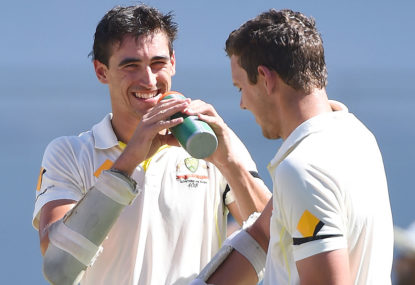Australia’s bowling stocks are so deep it seems likely they will unleash a fearsome five-man frontline attack upon the Test world in the near future, but it won’t happen in the Ashes.
A five-Test series can hurl forth all manner of unexpected events. It would, however, require a dramatic form surge from labouring wicketkeeper Brad Haddin for Australia to take the risk of promoting him to six to accommodate the extra bowler.
Australian wicketkeeper Brad Haddin has been in dire touch with the blade for 16 months now.
Over that period, he has made just 230 runs at an average of 15 from 11 Tests, and has grown incapable of playing with even a modicum of patience, restraint or responsibility.
While Haddin continues to bat like a monopoly millionaire at seven, Australia have less flexibility in their batting order.
That could change when he is replaced, perhaps by his understudy on the Ashes tour, Peter Nevill.
The 29-year-old could scarcely be more different to Haddin with the bat. Whereas the current Australian gloveman loves to unfurl expansive strokes from the start of his innings, Nevill is a grafter.
He boasts the kind of invaluable circumspection which reaped dividends for Steve Smith and Adam Voges in the Caribbean. Nevill is a Chris Rogers-type more worried about the volume of runs he hoards than the manner in which they are harvested.
Over the past two Sheffield Shield seasons, Nevill has plundered 1236 runs at 56, including three centuries. To put his efforts into context, here is a list of the top ten runscorers in the Shield over the past two seasons:
1. Adam Voges (WA) – 2127 runs at an average of 79
2. Michael Klinger (WA) – 1614 runs at 49
3. Tom Cooper (SA) – 1507 at 44
4. Ed Cowan (TAS/NSW) – 1447 at 43
5. Callum Ferguson (SA) – 1401 at 54
6. Rob Quiney (VIC) – 1367 at 46
7. Joe Burns (QLD) – 1357 at 50
8. Cameron Bancroft (WA) – 1346 at 35
9. Ryan Carters (NSW) – 1309 at 44
10. Peter Forrest (QLD) – 1280 at 45
This shows that, of batsmen with more than 1200 runs over the past two Shield seasons, only one had a better average than Nevill. That man, Adam Voges, is already in the Test XI.
Nevill’s returns are good enough to justify his inclusion purely as a batsman, not that such a situation is a possibility at this point.
If he replaces Haddin and can prove himself AS sturdy and prolific with the bat in Tests, Australia will be tempted to field five specialist bowlers.
Such an ultra-aggressive lineup would be made practical by the generous batting ability of Australia’s core unit of bowlers.
While none of Australia’s bowlers are skilful enough with the blade to be a traditional number seven, Mitchell Johnson, Ryan Harris and Mitchell Starc are all genuine number eight batsmen.
Meanwhile, Josh Hazlewood has shown requisite technique and temperament in his brief Test career, scoring 95 runs for only two dismissals. He isn’t far off being a number-eight standard batsman.
Then there’s the continual development with the blade and fighting qualities of number 11 Nathan Lyon. The off spinner is a batting barnacle, clinging on for 38 balls per dismissal in Tests.
Those five bowlers could be entrusted to contribute a decent slab of runs per Test. Of course, the appeal of such a lineup lies within its potential wrecking ball qualities in the field.
The variety, experience and penetration offered by an attack of Johnson, Harris, Starc, Hazlewood and Lyon would be overwhelming for opponents.
Even South Africa’s commanding batting lineup would be daunted by such a unit. Under the stewardship of Darren Lehmann, Australia have become the most aggressive side in world cricket.
There would be few more attacking moves than to combine that group of five bowlers.
So, when will it happen?
Haddin’s struggles suggest the Ashes is an unlikely venue for this selection strategy to be employed.
In the months after their tour of England, Australia have two of their easiest series in years – two Tests in Bangladesh and three Tests against the West Indies at home.
With all due respect to those opponents, Australia could comfortably win those series even if they fielded a second XI.
The low-key and lopsided nature of those contests will give the selectors the leeway to punt on playing five bowlers.
So, while we probably won’t see it in the Ashes, we may not have to wait too long to watch Australia play with an exciting, bowler-heavy lineup.





























































































